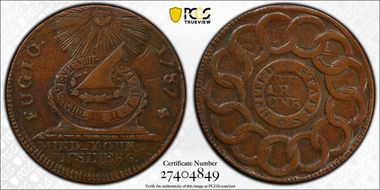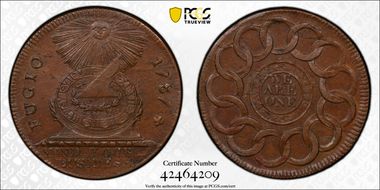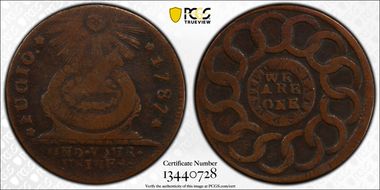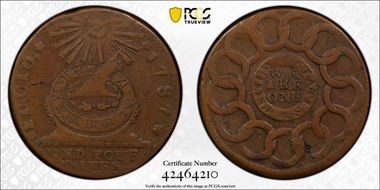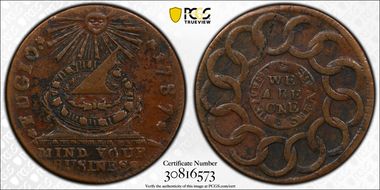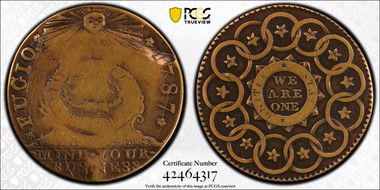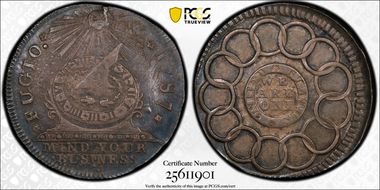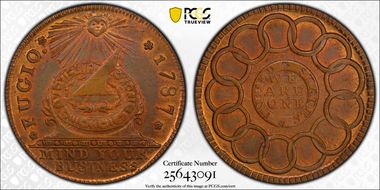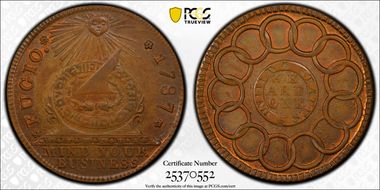The Dauntless Early American Collection of First Federal Coinage 的钱币相册
1-B R.4. UNITED STATES No Cinq with Cross
Newman 1-Z. R8. Probable Pattern. Cross after Date, No cinquefoils, STATES UNITED. Finest Known. Per cataloger, "Fugio Copper "Cent," Raised Rims, Cross After Date MS64 Brown NGC. CAC. Newman 1-Z, W-6610, R.7. 154.0 grains. The combination of the Cross After Date obverse and the Raised Rims reverse yields an extremely important single-variety type with claims to pattern status. In the "Fugio Files Updated, Part Twelve," published in the July 1994 issue of Penny-Wise, Michael McLauglin write: "The elements on this die were hand engraved which lends credence to the probability that this die was a pattern. Against this, however, the proportion of survivors of this variety in lower grade attests to their circulation. Perhaps a 'production pattern' designation to this die would not be appropriate." The hand engraving of both dies is not immediately obvious on lower grade pieces, but it is readily apparent on this Mint State piece. This Production Pattern issue may illustrate a stage in the Fugio design process as Michael Hodder suggested in the October 2003 Ford catalog. Since obverse 1 is identified as both a pattern and production obverse, the combination of these two dies is unprecedented among regular issue Fugios. Walter Breen recorded this variety and others from obverse 1 as prototypes of Jarvis & Company's New Haven Mint. The Norweb coin, plated in Newman's 2008 Fugio reference, was graded AU55. The finer of two in the Ford sale was called "Nearly About Uncirculated," which apparently means XF. The Eric P. Newman 1-Z is an impressive example and likely the finest known. The satin surfaces display splendid olive-brown color with a few splashes of steel toning. A few planchet rifts or laminations are typical of the Fugio series. Eric P. Newman Educational Society." Obtained from Heritage Auction on November 9, 2014, Lot 3046. Of note the 2nd finest is only PCGS AU58+ asking 85K in 8/2018.
4-E R3. "148.9 grains. Attractive dark chocolate brown with excellent detail for this variety. Some dark verdigris is built up around obverse legends and the reverse peripheries, but it does not seriously impact the eye appeal. Rim flawed above final 7 of date, light striations mostly reserved to right obverse field and right side of reverse. A few short old scratches are present in the left obverse field. Early die state with no crumbling inside the 8. From the Robert Ayers Collection. Earlier from Rosa Americana, Ltd. in March 1985. Paper envelope with attribution notation included," per Stacks Bowers cataloger. Obtained from Stacks Bowers Auction of the Robert Ayers Collection on August 14, 2013, Lot 1338.
4-E R3. "148.9 grains. Attractive dark chocolate brown with excellent detail for this variety. Some dark verdigris is built up around obverse legends and the reverse peripheries, but it does not seriously impact the eye appeal. Rim flawed above final 7 of date, light striations mostly reserved to right obverse field and right side of reverse. A few short old scratches are present in the left obverse field. Early die state with no crumbling inside the 8. From the Robert Ayers Collection. Earlier from Rosa Americana, Ltd. in March 1985. Paper envelope with attribution notation included," per Stacks Bowers cataloger. Obtained from Stacks Bowers Auction of the Robert Ayers Collection on August 14, 2013, Lot 1338.
Newman 103-EE. R8+. Norweb. Unique in Gold. Fugio Cent Restrike. Per cataloger, "New Haven Restrike, Stars in Rings, Gold, VF20 NGC. N. 103-EE, Breen-1345, W-17530, Unique. 13.59 gm. Entrepreneur Horatio N. Rust was the man behind the misnamed New Haven Restrike Fugio cents. Circa 1860, he contracted with the Waterbury, Connecticut, firm Scoville Manufacturing Company to produce several varieties from copy dies. Today, the Plain Rings variety (Newman 104-FF) is relatively plentiful in copper and brass, but the American Congress and Stars in Rings marriages (and their various trials) are formidable rarities. No genuine Fugio cents have stars within the rings, which makes it unclear why Rust designed the EE die with 13 reverse stars. He might have believed the variety could be marketed to collectors familiar with 13 stars on one side (and, sometimes, both sides) of early Federal coins. In any event, not many were made. Two or three pieces are known in silver, including the Col. Green - Eric Newman piece we offered as lot 3076 in our November 2014 Newman Part V Signature. One is known in brass, and Breen lists a copper example but adds it is untraced. The gold example is unique, and was likely the final piece struck from the Newman 103-EE die pair, given the central failure of the obverse die. The obverse border also exhibits a network of fine die cracks. Presumably, the obverse die was not hardened prior to use. The high points are honey-gold, while the fields are tan-brown. No marks are noticeable, but the high-point wear evident on both sides indicates it must have been carried as a pocket piece. The wear may have been an attempt by Rust or an early owner to increase its acceptance as authentic by the 19th-century numismatic community. The present example appeared as lot 661 in the New York Coin & Stamp Co. auction of the celebrated Lorin G. Parmelee collection, and was described as having "no duplicate known in either type or metal." Parmelee sold it to Virgil M. Brand in 1899. Listed on page 90 of the 2021 Guide Book. Ex: Lorin G. Parmelee (New York Coin & Stamp Co., 6/1890), lot 661, where it was bought in; Lorin G. Parmelee (7/31/1899); Virgil M. Brand (Journal #20690); Brand Estate; later, Jon Hanson; Donald G. Partrick." Obtained from Heritage Auction of Donald Partrick Collection on April 22, 2021, Lot 3039.
Newman 105-QQ. R7+. Silver Restrike Fugio Cent. Obtained by private treaty from Harry Laibstain Rare Coins on April 1, 2016.
104-FF Finest Known. Mostly red with strong strike and luster. Obtained by private treaty with Harry Laibstain on December 20, 2015.
104-FF in Brass. Per cataloger at Stacks Bowers, "Deep tan-gold throughout with traces of mint orange here and there in the protected areas. Sharply struck from copy dies reportedly found in the Broome & Platt storefront in New Haven, Connecticut in the 1860s. Choice for the grade." Obtained from Stacks Auction on 11/7/2015, Lot 23255.






















